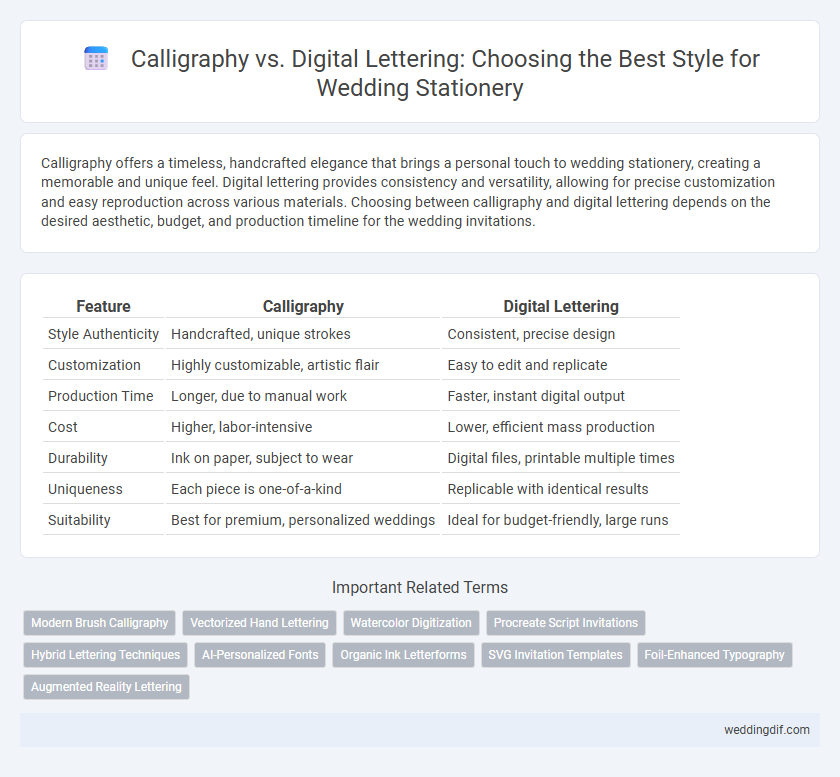Calligraphy offers a timeless, handcrafted elegance that brings a personal touch to wedding stationery, creating a memorable and unique feel. Digital lettering provides consistency and versatility, allowing for precise customization and easy reproduction across various materials. Choosing between calligraphy and digital lettering depends on the desired aesthetic, budget, and production timeline for the wedding invitations.
Table of Comparison
| Feature | Calligraphy | Digital Lettering |
|---|---|---|
| Style Authenticity | Handcrafted, unique strokes | Consistent, precise design |
| Customization | Highly customizable, artistic flair | Easy to edit and replicate |
| Production Time | Longer, due to manual work | Faster, instant digital output |
| Cost | Higher, labor-intensive | Lower, efficient mass production |
| Durability | Ink on paper, subject to wear | Digital files, printable multiple times |
| Uniqueness | Each piece is one-of-a-kind | Replicable with identical results |
| Suitability | Best for premium, personalized weddings | Ideal for budget-friendly, large runs |
Introduction to Wedding Stationery Typography
Wedding stationery typography plays a crucial role in setting the tone and style of the event, with calligraphy offering a timeless, handcrafted elegance characterized by fluid, artistic strokes. Digital lettering provides versatile design options and consistency, enabling precise customization and efficient reproduction for large quantities. Both techniques contribute distinct aesthetic qualities, making the choice dependent on the desired wedding theme and personal preference.
What is Calligraphy?
Calligraphy is the art of hand-lettering that emphasizes elegant, flowing strokes created with specialized pens or brushes, offering a personalized and timeless aesthetic for wedding stationery. Unlike digital lettering, which is produced using software, calligraphy showcases the unique touch of an artist's hand, adding a sense of luxury and craftsmanship. This traditional technique enhances invitations, place cards, and envelopes with distinct flourishes that convey sophistication and attention to detail.
What is Digital Lettering?
Digital lettering uses software tools to create precise, customizable letter designs for wedding stationery, allowing for easy edits and consistent results. Unlike traditional calligraphy, which relies on hand-drawn strokes and ink variations, digital lettering replicates handwriting styles through vector graphics, ensuring scalability without loss of quality. This modern technique enhances creativity by integrating various fonts, colors, and effects, making it ideal for personalized and elegant wedding invitations.
Pros of Calligraphy for Wedding Stationery
Calligraphy adds a timeless elegance and personalized touch to wedding stationery, enhancing the overall aesthetic with handcrafted artistry. The unique variations in ink flow and pressure create a distinct, organic feel that digital lettering cannot replicate. Custom calligraphy ensures each invitation feels bespoke, making it a cherished keepsake for couples and guests alike.
Pros of Digital Lettering for Wedding Stationery
Digital lettering for wedding stationery offers unparalleled precision and consistency, ensuring every invitation maintains perfect alignment and uniformity. Customizable design options enable easy incorporation of unique fonts, colors, and decorative elements tailored to the wedding theme. Faster production times and cost-effectiveness make digital lettering a practical choice for large orders without sacrificing aesthetic appeal.
Aesthetics: Comparing Calligraphy and Digital Lettering
Calligraphy offers a timeless, handcrafted elegance with unique flourishes and organic variations that enhance the personal feel of wedding stationery. Digital lettering allows precise control over font styles, colors, and consistency, making it ideal for clean, modern aesthetics with swift production. Both approaches create visually appealing designs, but calligraphy emphasizes artistic individuality while digital lettering excels in customization and reproducibility.
Customization and Flexibility
Calligraphy offers unique, hand-crafted customization with each stroke reflecting the artist's skill, ideal for intimate, personalized wedding stationery. Digital lettering provides unparalleled flexibility, allowing easy edits, consistent typography, and integration with various design elements for cohesive themes. Both methods cater to customization, but digital options streamline revisions and scalability, while calligraphy emphasizes artistic individuality.
Cost Considerations
Calligraphy for wedding stationery often involves higher costs due to the specialized skills, time, and materials required for handcrafted designs. Digital lettering offers a more budget-friendly alternative with quicker turnaround times and easy customization options, making it ideal for large print runs. Couples must weigh the value of artisanal uniqueness in calligraphy against the affordability and efficiency of digital lettering to decide the best fit for their wedding budget.
Turnaround Time and Efficiency
Calligraphy offers a timeless, handcrafted elegance for wedding stationery but requires significant turnaround time due to its manual nature, often taking days to complete each piece. Digital lettering dramatically increases efficiency, allowing for quick revisions, consistent quality, and faster production, often delivering final designs within hours. Choosing between calligraphy and digital lettering depends on balancing the desire for artisanal authenticity against the need for rapid turnaround and streamlined workflow.
How to Choose the Best Style for Your Wedding Invitations
Calligraphy offers a timeless, handcrafted elegance with unique flourishes that add a personal touch to wedding invitations, appealing to couples seeking traditional sophistication. Digital lettering provides precise, versatile designs with consistency and customization options ideal for modern or themed weddings. To choose the best style, consider the wedding's overall aesthetic, budget constraints, and whether you prefer the artisanal charm of hand-lettered calligraphy or the sleek adaptability of digital fonts.
Calligraphy vs Digital Lettering for wedding stationery Infographic

 weddingdif.com
weddingdif.com